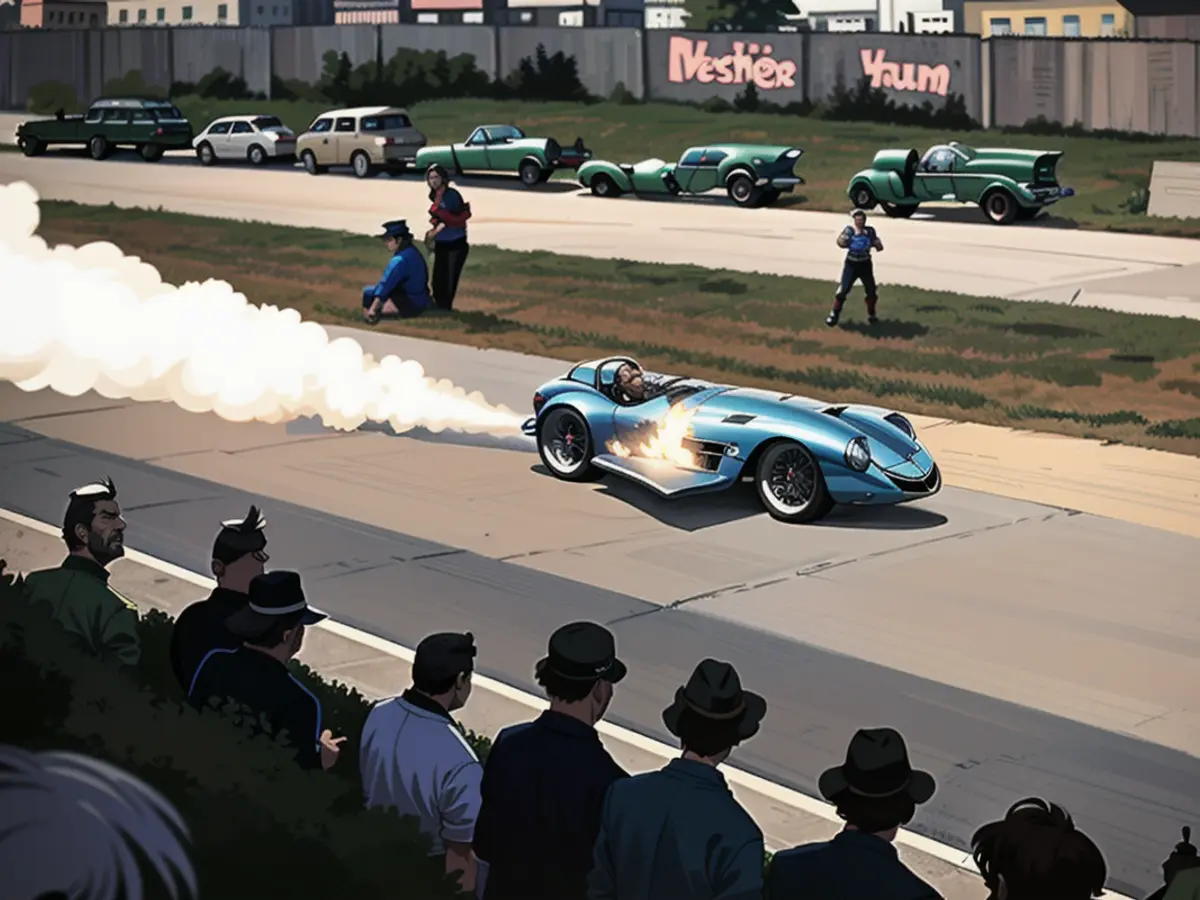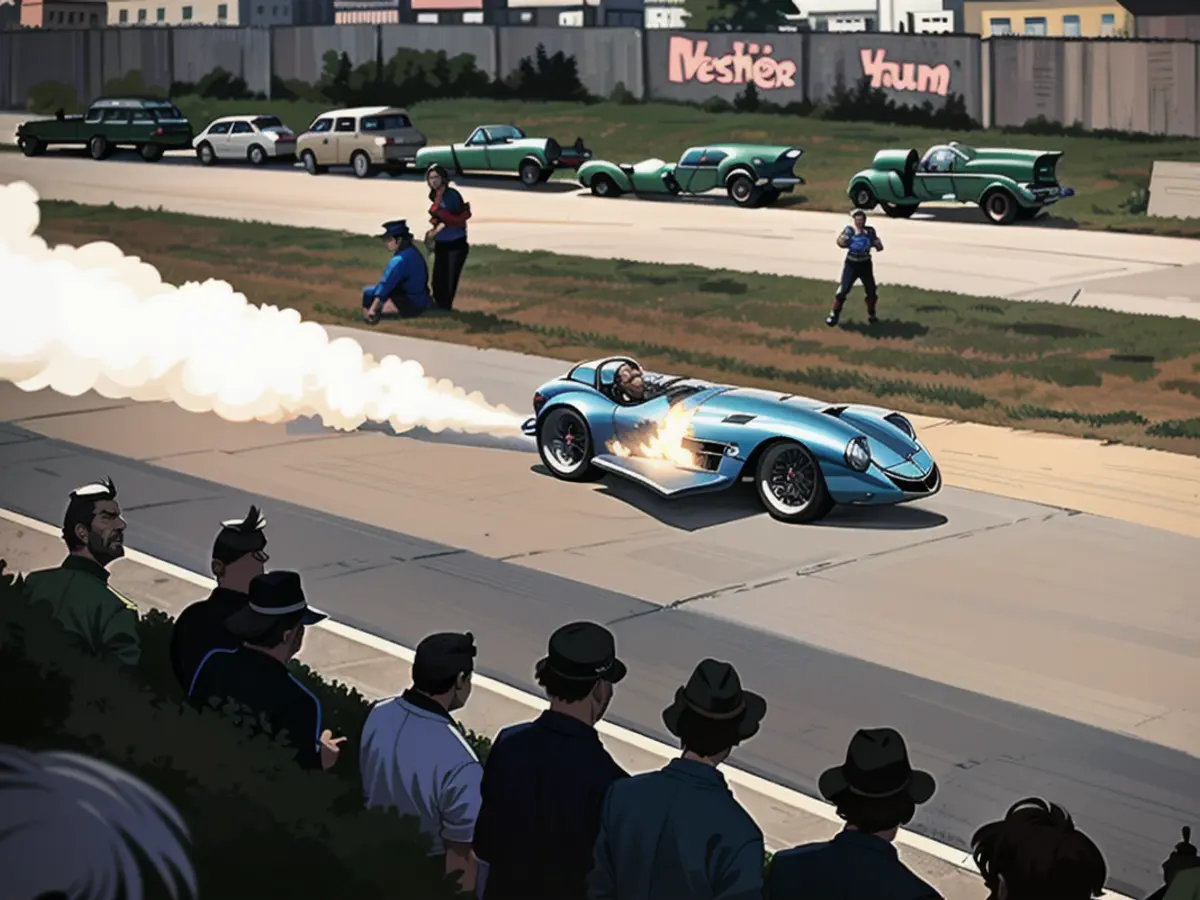The Opel RAK 2 makes a speedy journey through history.
This year, Opel turns 125 years of producing cars at their Rüsselsheim facility. Over these years, they've made numerous models for the road and the track. Some of these models are incredible, like the RAK 2, which set a record at the AVUS track in 1928 by reaching 238 km/h. The chance to drive one of these beauty machines is a dream come true.
Back in the day, it was a cloudy Wednesday in Berlin, and around 3,000 spectators couldn't comprehend what they were witnessing. A black cigar-like vehicle with a glowing red tail of fire and smoke, propelled by 24 rockets each over a meter long and weighing five kilograms, broke the track record at the legendary AVUS. At the wheel was Fritz von Opel, a multitalented individual – an engineer, a racing driver, a record-chaser, and a daredevil. Just 29 years old at the time, he'd already won races in cars, motorcycles, and even boats. He etched his name in the history books once again with this feat.
The RAK 2 had no relation to the successful vehicles, like the Opel 4 PS, the Laubfrosch, of that era. Opel, the grandfather of company founder Adam Opel, had built the unique car with Austrian rocket pioneer Max Valier and pyrotechnician Friedrich Sander, specifically for the Berlin race. The incredible power he unleashed with each rocket almost led to disaster, but he loved it.

Opel said, "I kick again, again, and - it seizes me like a rage for the fourth time. Everything vanishes to the side. (...) I only act subconsciously. Behind me, the rush of uncontrollable forces." However, the car's massive wings couldn't save it from losing traction just before the finish line, almost causing it to take flight. Leif Rohwedder adds the untold story: the RAK 2 hadn't been seen since Opel was taken over by General Motors and lost during World War II.
Opel treasures the memory of this record-breaking car and keeps a replica in their collection. This replica was made in the 1990s for an advertising campaign but never used. It's closer to the original than the replica in the Deutsches Museum in Munich and can even be driven. According to the proud collection manager, it's more than just a static attraction. He clears the dust off the black paint, slots the massive wings into the fuselage with ease, and invites visitors to take a test drive on their property.
The eight plugs from a 5.7-liter engine of a Chevrolet Camaro were used instead of solid-fuel rockets, and completely dismantled for this project under General Motors' direction. The mocked pipes that once housed the propulsion engines now hold church candles, and fog represents the smoke.
On the outside, the comparatively refined combustion engine with its steady 200 hp gives you an idea of the heroism required to set this record. After a few minutes, the engine's tubing is piping hot. It's difficult to find the accelerator and brake in the cramped cockpit.
Yet, a photographer urges us to drive fast, reminding of the 238 km/h record from long ago. Meanwhile, you try to navigate this rocket through a maze of brand new cars eagerly awaited by customers and avoid any collisions. This isn't the mighty AVUS with its four-kilometer straight track. Instead, you're at a cramped factory site with oncoming traffic and tight spaces.
However, there's a free stretch of road somewhere further along. In the narrow tunnel ahead, you can feel the foot sinking slightly toward the floor pan as the RAK 2 accelerates with an incredible roar. Its maneuverability becomes more difficult and the nose's precise direction can now only be maintained with an iron grip.
It's difficult to fathom the excitement von Opel must have felt as one rocket after another lit up behind him, propelling the RAK 2 to incredible speeds. The crowd's adoration only increased his prestige, earning him the nickname "Rocket Fritz."
Unfortunately for Von Opel, he enjoyed limited success in his venture. Although the RAK 2 led to the development of the record-breaking RAK 3 rail vehicle and a rocket-powered plane, he faced a demise when his family sold their company to General Motors in 1929. "The rocket tests turned Opel into the most progressive and innovative car manufacturer," explains Rohwedder, "but the Americans weren't interested in Opel's grand plans. They scrapped all his projects."
Controllable rocket technology - evolving into the space age
The RAK 2 is a reminder not just of a remarkable vehicle and an impressive addition to Opel's collection, but also of a pivotal moment in the history of technology, one that transcends the automotive scene. Instead, it signals the dawn of an entire new era - the space age. "With this car, Opel established that rocket propulsion could be powerful and controlled," says Rohwedder, "and hence marked the beginning of a completely new field."
With the RAK 2 replica, Opel keeps this landmark moment alive.
Read also:
- Despite being acquired by General Motors, Opel still cherishes the record-breaking Opel RAK 2, as they have a replica of the vintage car in their collection.
- The Opel RAK 2, created in collaboration with Austrian rocket pioneer Max Valier and pyrotechnician Friedrich Sander, showcased Opel's innovative spirit even before joining General Motors.
- The unique Opel RAK 2, which set a record on the AVUS track back in 1928, paved the way for advancements in controlled rocket technology and eventually led to the space age.
Source: www.ntv.de








